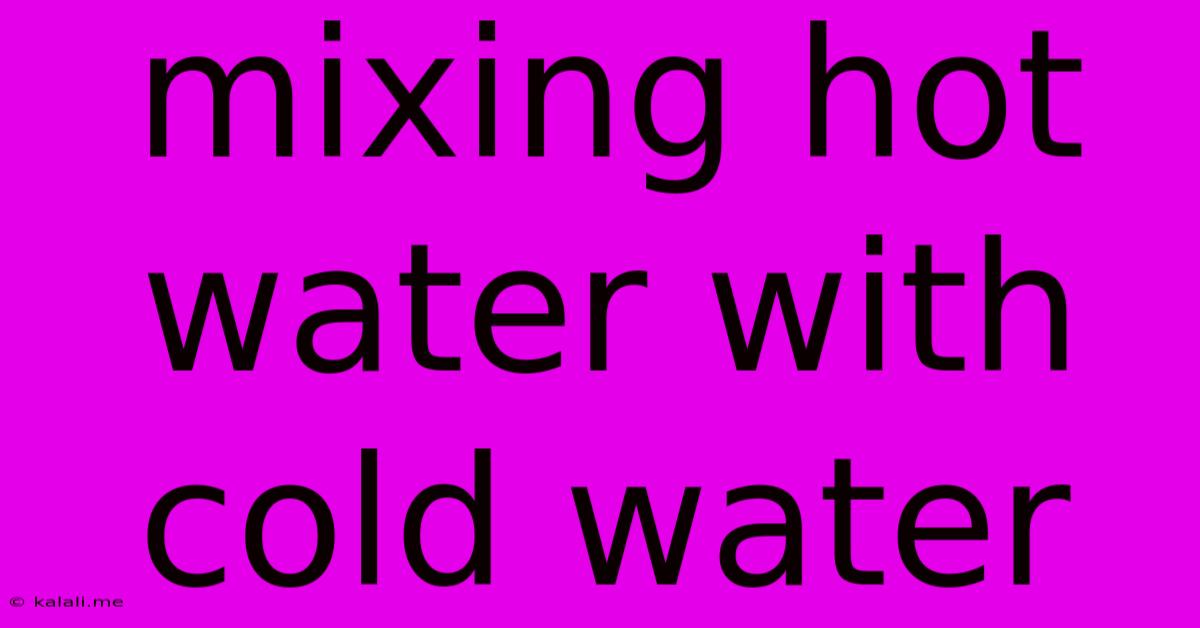Mixing Hot Water With Cold Water
Kalali
May 22, 2025 · 3 min read

Table of Contents
The Science and Art of Mixing Hot and Cold Water: Achieving the Perfect Temperature
Mixing hot and cold water seems simple, right? Just turn the taps and voilà! But there's more to this everyday action than meets the eye. This article delves into the science behind temperature mixing, explores practical applications, and offers tips for achieving the perfect temperature every time. Understanding this seemingly mundane process can lead to improved efficiency and safety in various situations.
Why Does Mixing Hot and Cold Water Matter?
The seemingly simple act of mixing hot and cold water has significant implications across numerous fields. From everyday comforts like showering and washing dishes to industrial processes requiring precise temperature control, understanding how temperature equilibrates is crucial. This knowledge translates to energy savings, improved safety protocols, and enhanced efficiency in various tasks.
The Physics of Thermal Equilibrium
The process of mixing hot and cold water is governed by the principles of thermodynamics, specifically the concept of thermal equilibrium. When you combine water of different temperatures, heat energy transfers from the hotter water to the colder water until both reach a uniform temperature. This final temperature is an average, influenced by the initial temperatures and volumes of the hot and cold water.
The rate at which this equilibrium is reached depends on several factors including:
- Initial temperature difference: A larger difference between the hot and cold water temperatures will result in faster heat transfer.
- Volume of water: Larger volumes of water will take longer to reach equilibrium.
- Mixing method: Vigorous stirring or turbulence accelerates heat transfer compared to gentle mixing.
- Material of the container: The thermal conductivity of the container affects heat loss to the surroundings.
Practical Applications of Mixing Hot and Cold Water
Mixing hot and cold water is crucial in many aspects of daily life and industry:
- Domestic use: From taking a shower to washing dishes, adjusting the water temperature is essential for comfort and hygiene. Understanding how much hot and cold water to combine helps achieve the desired temperature efficiently and reduces water waste.
- Industrial processes: Many industrial processes require precise temperature control. Mixing hot and cold water is vital in applications such as chemical reactions, cooling systems, and food processing.
- Heating and cooling systems: Central heating and cooling systems rely on mixing hot and cold water to regulate the temperature of a building or facility. Efficient mixing ensures uniform temperature distribution.
Tips for Achieving the Perfect Temperature Every Time
Achieving the desired water temperature consistently requires a bit of practice and understanding:
- Start with a base: Begin by running either hot or cold water to establish a starting point. Then, gradually introduce the other temperature until the desired blend is achieved.
- Use a thermometer: For precise temperature control, particularly in industrial settings, using a thermometer ensures accuracy.
- Consider water pressure: High water pressure can make it difficult to achieve a precise balance between hot and cold water. Adjusting the pressure can improve control.
- Experiment: The best way to find the perfect mix is to experiment and develop a feel for the ratio of hot and cold water needed.
Conclusion: More Than Just Mixing
Mixing hot and cold water is a deceptively complex process with far-reaching applications. By understanding the underlying physics and practical considerations, we can optimize this everyday action for improved efficiency, comfort, and safety, whether in our homes or in industrial settings. The principles of thermal equilibrium, while seemingly simple, are fundamental to countless processes and deserve a deeper appreciation.
Latest Posts
Latest Posts
-
What Does Emulsify Mean In Digestion
May 22, 2025
-
Can You Connect Two Bluetooth Headphones
May 22, 2025
-
How To Make Coconut Milk From Cream
May 22, 2025
-
Walk From St Pancras To Euston Station
May 22, 2025
-
Where Am I Signed In On Google
May 22, 2025
Related Post
Thank you for visiting our website which covers about Mixing Hot Water With Cold Water . We hope the information provided has been useful to you. Feel free to contact us if you have any questions or need further assistance. See you next time and don't miss to bookmark.